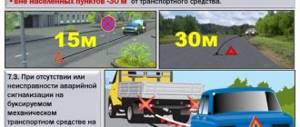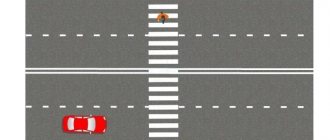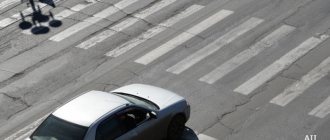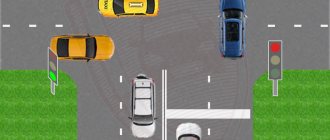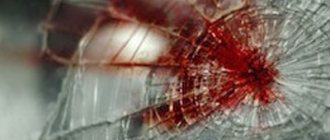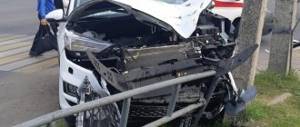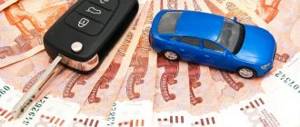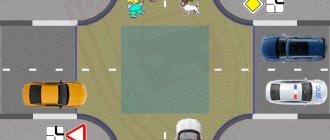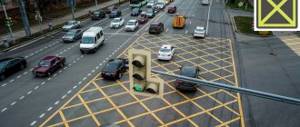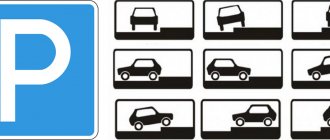The movement of cars in dense city traffic presents drivers with a number of difficulties and difficulties. And when special transport in the form of an ambulance also joins the general flow, some motorists are completely lost, do not know how to act and what to do next.
The issue of allowing an ambulance to pass is a really complex and pressing one. It is unlikely that anyone consciously wants to receive a fine or even lose their license for several months. But sometimes a driver is punished in a situation where he essentially did everything right, allowed special vehicles to pass, and in fact violated Russian traffic regulations.
Therefore, it is recommended to understand how to act correctly in a given situation and what the current Traffic Rules tell us.
When drivers agree to yield
Traffic priority for vehicles equipped with special signals, including ambulances, is specified in paragraph 3.1 of the current traffic rules.
In order for a special vehicle to gain an advantage, it must first turn on the corresponding blue beacon and also activate the sound signal. You can take advantage of the due priority only in a situation where the ambulance driver is convinced that they have given way to him.
It is important to consider that to obtain priority, two conditions must be met simultaneously. Namely, the included light beacon and sound special signal. If an ambulance simply honks with a regular horn, it does not impose a right of way on other drivers.
The driver can receive a fine or even lose his license for some time only in a situation if all the requirements for priority on the part of the ambulance were met, but the motorist still did not provide priority to the special transport.
How to give way and the pitfalls of traffic rules
The procedure according to which a motorist must give way to a special vehicle, that is, an ambulance in the situation under consideration, is prescribed in paragraph 3.2 of the traffic rules. When a vehicle with a beacon and sound signal approaches, other drivers undertake to give way and give priority.
The current rules are actually based on the terms approved by the traffic rules regarding the right of way and the concept of giving way.
Advantage or priority is the right that provides priority movement in the intended direction before other motorists and road users;
To give way or not to interfere is defined as a requirement. According to it, traffic participants should not continue, resume or start moving or perform any maneuvers if these actions force the car with priority (advantage) to change its direction or speed.
According to current laws, based on the terms of the traffic rules, the driver is obliged to act in exactly this way. The presented terminology is relevant when crossing intersections, turning, changing lanes and other maneuvers. But the rules do not consider a separate case where we are talking about cars equipped with special signals approaching from behind.
Now let's sum up the intermediate results. When a driver sees or hears an ambulance approaching behind him, he is obliged to act in accordance with traffic rules. Namely, stop, do not continue or resume movement, and do not maneuver. Essentially, he must press the brake and stop his vehicle. The rules clearly state that it is prohibited to continue moving and maneuvering. But at the same time, we do not forget that there is another undefined requirement regarding ensuring unimpeded passage.
It's not difficult to imagine how all this will look in practice. From a legal point of view, the driver will comply with the law if he brakes and does not move. But in such a situation, the ambulance will not be able to pass, since the maneuver is prohibited by law. In theory, the driver needs to push to the right, and only then stop. This is not stated in the law or requirements. This is where conflict situations arise.
In practice, no one will punish the driver if he first makes a maneuver and only then stops, thereby ensuring free passage for the ambulance, but in fact violating the traffic rules. But if the driver fulfills all the requirements strictly within the law, braking and not maneuvering, then a fine may be issued. De jure, he complied with the requirements of the traffic rules, but in fact he did not allow a car with a special signal to pass or blocked the passage.
If we talk about real conditions, then the most correct decision on the part of the driver would be to turn to the right, clear the roadway for the special vehicle as far as possible, and only then finally stop. Surely no one will fine you in such a situation.
In what cases is it necessary to skip the ambulance?
Providing an advantage on the road to a medical ambulance can decide the fate of saving a patient or victim. According to paragraph 1.2 of the traffic rules, advantage on the road or priority is the ability to move along the roadway, evading certain traffic rules.
These rules include:
- the need to comply with traffic lights;
- prohibition of overtaking or driving along the oncoming lane;
- speed limits;
- stopping and parking rules.
The rules spell out clear conditions for unquestioning passage of an ambulance. Traffic regulations clause 3.2 states: all road users are required to give way to special vehicles that have:
- included blue flashing pendulums;
- switched on special sound siren.
These mandatory conditions are uncompromising. It happens that ambulance drivers are urged to turn on their flashing lights even when not on emergency calls, which do not require any rush at all. Urgent emergency calls require the use of an audible siren, which is an unshakable reason to give way to the ambulance, rather than separately turned on beacons.
The siren's sound signal must have a special sound - a sharp warning audio signal; a monotonous howl is not considered an indication for the provision of a clear road. There have been strange, unpleasant cases of fining car owners who ignored an “ambulance” with only one beacon on. Legislation forces citizens to be especially vigilant.
However, there are many ambiguous rules in force on the territory of the Russian Federation. Some laws contain rather vague concepts, devoid of clear instructions on clearing the road lane for an ambulance moving behind a special vehicle.
How to act correctly when an ambulance approaches
There are a number of rules that a driver must follow when he sees an approaching car equipped with special signals. These include ambulances.
https://www.youtube.com/watch?v=rwlFgLYc_ws
First, the driver needs to make sure that he really undertakes to give way in this situation. Here we are talking about compliance with two conditions associated with the inclusion of a flashing blue beacon and an audible siren. If the ambulance complies with these conditions, the driver must:
- slow down or stop the vehicle completely;
- do not resume movement until the special vehicle has passed;
- if it is possible to clear the roadway, a maneuver is performed;
- if the car is stationary, do not start driving until special vehicles pass by;
- if the car was moving, stop to allow a special vehicle to pass;
- if in order to pass and provide an advantage it is necessary to change lanes or press down, such a maneuver is performed only on the condition that it is performed according to the rules and does not create inconvenience for other vehicles.
There is nothing complicated here. Although the ambiguity of the interpretation of the law raises some doubts as to whether it is worth performing the maneuver or not. By law, you can't maneuver. But sometimes it is impossible to give way otherwise. Therefore, it is better to turn and hug the side of the road rather than block the ambulance.
When an ambulance can violate general traffic rules
An ambulance belongs to the category of vehicles that have a certain right to conditionally violate existing traffic rules. The corresponding right is determined by the presence of special signals. With their help, they gain an advantage, which sometimes entails breaking the rules. For example, using special signals, an ambulance can not allow pedestrians to pass, drive through a red traffic light, etc.
There are several important points regarding ambulance and general traffic rules:
- An ambulance can only take advantage if there is a corresponding need. Here we are talking about the need to urgently get to the patient or take the patient to the hospital.
- The ambulance driver can deviate from the rules only when he is convinced that they are actually giving way to him, and his actions do not provoke the creation of emergency situations.
- The ambulance cannot violate the traffic controller's signals. Even if the sound and light special signal is turned on. Here the traffic controller himself is obliged to organize the passage of the section in such a way as to allow the special vehicle to pass as quickly as possible.
- The ambulance does have the right to violate traffic rules in some cases. But not always and not everywhere. If the driver does not turn on one of the signals, then the same driving on red will be considered an offense. The driver will receive a fine.
- Before expecting priority from other road users, ambulance drivers are required to fulfill the requirements placed on them, without which no one should yield to them, and accordingly, no fine will be issued to such drivers.
How to correctly give way to an ambulance and a fire truck
When an ambulance approaches, drivers are required to “give way to ensure unhindered passage of the specified vehicle.
Photo: Andrey TSYGANOV
The Internet is full of videos of how in Europe or Japan they let through an ambulance driving with its flashing lights on. Disciplined, synchronized, as if it were a specially choreographed production. In our country, if a siren howls from behind, they often move away as if reluctantly; neighbors downstream rarely move to make room for those giving way. If you start to be publicly indignant somewhere, you will immediately find someone who claims that it is not the sick person inside, but someone who avoids traffic jams for money. And the firefighters, naturally, are in a hurry to get beer. It sounds ugly, disgusting, because we are talking about saving lives, in such a matter every second is precious. But not everyone tries this on themselves... But there is always room for improvement, you just need to try.
Arithmetic is simple
Suppose an ambulance is trying to squeeze through on a road where oncoming directions are separated by a barrier. This usually happens on wide roads - three lanes or wider. Typically, the driver drives the car in the middle of the lane so that there are larger gaps to the sides. But the width of the standard GOST lane on such roads is 3.5 - 3.7 m. The right lane in cities where trolleybuses operate can easily be 4 meters. But even if the lane is only three meters wide, which happens on non-high-speed roads, then two lanes will not be narrower than six meters. And usually wider, even more than seven. At the same time, a standard passenger car, taking into account the side mirrors, is slightly more than 2 m wide. Without taking into account the mirrors, it is usually 1.7 - 1.8 m. Let's sum it up and we get that three cars in width can easily fit on two lanes.
Only in order to give way to ambulances and fire trucks, those traveling in the right lanes must carefully move as far to the right as possible (see diagram). Few people do this, they usually drive according to the principle “my house is on the edge”, let the one who interferes with the flashing lights dodge. But if you turn on your head and turn off indifference, even in the narrowest places and the densest traffic jams you can let a car pass.
How to correctly give way to an ambulance and a fire truck
Photo: Dmitry POLUKHIN
Give in right
If someone quacks or flashes something, don’t rush to the side. Not all cars with light and music have priority rights. Here are two signs of a car you should miss:
1. Special color schemes, inscriptions and designations applied to external surfaces (police, ambulance, fire, etc.).
2. At the same time, a blue (not orange!) flashing light and (not or!) a special sound signal are turned on. In addition to the blue flashing light, a red flashing light can be included.
When such a car approaches, drivers are required to “give way to ensure unimpeded passage of the specified vehicle, as well as the vehicle (accompanied by it),” as it is written in the Traffic Rules. Overtaking such cars, including escorted ones, is prohibited.
Rights can be taken away
About a year and a half ago, everyone was discussing a proposal to allow ambulances to ram cars that are in their way. Just hit them and move them out of the way if they are blocking the passage. But the driver will not get anything for this; the insurance company will compensate for the repair costs, and then they will rip this money off from the owner of the car that interfered with the patient’s journey.
— Responsibility for not allowing emergency vehicles to pass has not been changed. When a high-profile incident occurred - the car was not allowed to go to the patient, on this wave, some officials and social activists decided to loudly declare themselves, proposed to tighten sanctions up to criminal punishment, but things did not go beyond words, explains lawyer, auto expert Sergei Smirnov. — Now for “failure to provide priority in traffic” to an emergency vehicle under Article 12.17 (Part 2) of the Code of Administrative Offences, the driver can be punished with a fine of 500 rubles or even deprived of the right to drive for a period of one to three months.
Current fines
Now it’s worth touching on the topic of fines for not allowing an ambulance to pass. The corresponding penalties are regulated by the Code of Administrative Offences. The fine associated with failure to comply with the requirements to give way is subject to Article 12.17, Part 3.
It is important to consider one key detail. Punishment for the fact that the driver did not allow a special vehicle, that is, an ambulance, to pass, is possible only if an advantage is not provided. If drivers allow an ambulance to pass but do not ensure unhindered traffic, no one will issue a fine for this. There are no such provisions in the law. And if there are no rules and requirements, then penalties cannot exist.
Currently, there are two options for administrative penalties for the fact that a motorist did not give way to an ambulance. A driver who fails to yield in such a situation may receive a fine. Which one depends on the specific case.
- If the driver of a vehicle is not inferior to a car equipped with special signals (blue beacon and sound siren), as well as having a special emergency graphic diagram, and the signals themselves are turned on, then the fine will be 500 rubles.
- The second situation applies to cars with special signals, but without graphic circuits. This applies to cars of deputies, special services, etc. Here the fine will vary from 100 to 300 rubles.
The law does not establish any time frame, according to which the driver undertakes to fulfill all the conditions within a certain time by giving way.
There are situations when the driver faces not just a fine, but also deprivation of his license. The maximum period for confiscation of a driver's license is 3 months.
But a motorist may have his license taken away in a situation where a violation was recorded by traffic police officers. Therefore, most often we talk about deprivation of rights only when the traffic police, traffic police or other similar departments do not allow a car to pass. Your license can be taken away if the driver, during a maneuver, trying to provide an advantage, violated other traffic rules.
If the driver was drunk and overtook an ambulance with active special signals, then a huge fine will follow, and the license will be taken away for 1-3 years.
Is there a fine for not giving way to an ambulance?
Evasion of the requirement to give way to an ambulance by a driver may result in administrative liability. The fine for failure to provide access for an ambulance is five hundred rubles.
The same applies to the case with other official vehicles that have special signals (fire truck, police car). Special color schemes for the body of a company car are an optional condition for providing an advantage on the road. In the case of cars without special color schemes (cars of civil servants, etc.), a fine of 100 - 300 rubles is imposed. In a bill previously considered by the state, fines could be tightened to 1,500 - 30,000 rubles.
